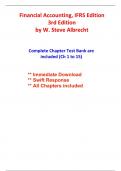Exam (elaborations)
Test Bank for Financial Accounting, IFRS Edition, 3rd Edition Albrecht (All Chapters included)
- Course
- Institution
Complete Test Bank for Financial Accounting, IFRS Edition, 3rd Edition by W. Steve Albrecht, Audrey Wenhsin Hsu, Earl K. Stice, James D. Stice, Monte R. Swain, Rong-Ruey Duh ; ISBN13: 9789814962582. (Full Chapters included Chapter 1 to 15).... 1. Accounting Information: Users and Uses. 2. Financi...
[Show more]



